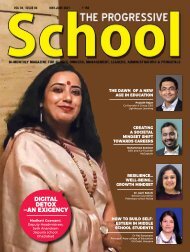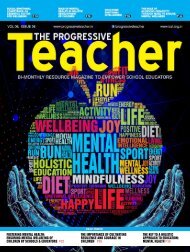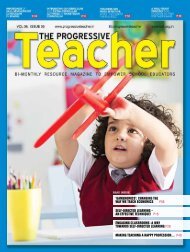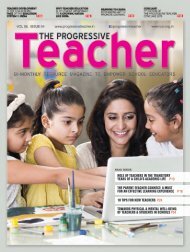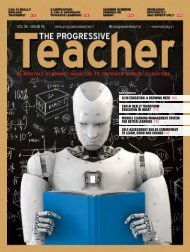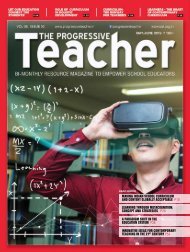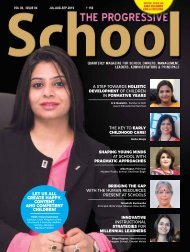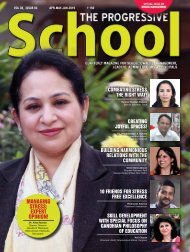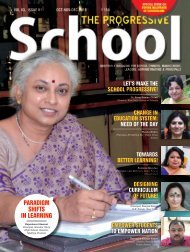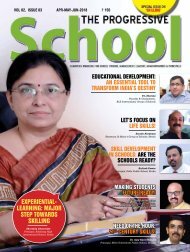The Progressive Teacher Vol 04 Issue 03
This issue of The Progressive Teacher focuses on "New Trends in Education ". In this edition, articles explore contemporary trends to enhance interactive learning amongst students.
This issue of The Progressive Teacher focuses on "New Trends in Education ". In this edition, articles explore contemporary trends to enhance interactive learning amongst students.
Create successful ePaper yourself
Turn your PDF publications into a flip-book with our unique Google optimized e-Paper software.
Student Support System:<br />
Successful learning, besides many other<br />
things, requires different levels of support<br />
depending upon the needs of each individual<br />
learner. Student support services provide<br />
not only individual feedback to learning<br />
community, they provide the learners access<br />
to counseling support where and when<br />
required. Schools can start individual student<br />
support system that can work regularly and<br />
help children when they are in academic or<br />
non academic crisis. Student Support within<br />
the school curriculum can be divided into the<br />
following areas -<br />
Literacy Target<br />
Group:<br />
Numeracy Target<br />
Group<br />
Individual Needs<br />
Group<br />
Gifted and<br />
Talented Group<br />
For children whose<br />
literacy acquisition<br />
skills are poor and<br />
need Language<br />
support.<br />
For children<br />
whose numeracy<br />
acquisition skills<br />
are poor and need<br />
special remedial<br />
benefit from extra<br />
Maths Support.<br />
For students who<br />
need special care<br />
because of their<br />
educational needs<br />
as they can’t carry<br />
on their unmodified<br />
curriculum.<br />
For students<br />
who perform<br />
exceptionally<br />
well and need<br />
enhanced learning<br />
programmes and<br />
curricula to do<br />
superbly.<br />
Joint Home Learning Agreement:<br />
Teaching-learning is a joint undertaking<br />
between teachers and learners. Learning of a<br />
child is not confined to the school campus and<br />
it derives value from the home environment.<br />
Home learning is a shared responsibility<br />
between the student, teacher and family. In<br />
our schools we regularly remain in touch with<br />
parents and family members of our students<br />
so that a joint agreement is reached. <strong>The</strong>re<br />
is proved evidence that after establishing<br />
healthy home-learning environment, children<br />
learn independently getting support from all<br />
quarters. Joint Home Learning environment<br />
provides a child confidence and support to<br />
enhance learning skills and also provides the<br />
child and parents timely feedback to counter<br />
learning challenges.<br />
Calibrating Collaborative Team Teaching:<br />
Can having more than one teacher in the<br />
classroom help students learn better? In<br />
our schools we regularly transform our<br />
classrooms into massive learning platforms<br />
where teachers join in to support children’s<br />
learning at several levels. Collaborative<br />
team teaching often occurs in an inclusive<br />
classroom. In a co-taught class, general<br />
education and special education teachers<br />
work together to plan lessons, teach and<br />
monitor student progress and manage the<br />
classes.<br />
Being in a co-taught classroom<br />
has many benefits. Students<br />
can spend more time with the<br />
teachers and get more individual<br />
attention. And with more than<br />
one teacher, it’s easier to teach<br />
students in smaller groups or on<br />
a one-on-one basis.<br />
Moreover, students have the<br />
opportunity to learn from<br />
two teachers who may have<br />
different teaching styles, ideas,<br />
perspectives and experience. In<br />
Collaborative team teaching, the<br />
curriculum is divided into several<br />
chunks and each team member<br />
takes up different tasks aiming to<br />
address the learners’ difficulties,<br />
choices and requirements.<br />
Replacing Over Testing<br />
with Learning Measurement:<br />
In recent years our education system has<br />
undergone many changes in terms of teaching<br />
and learning measurement. CBSE and<br />
many state board schools are now adopting<br />
standardized teaching learning assessment.<br />
Junking the CCE pattern the new scheme<br />
of evaluation aims to bring uniformity in<br />
educational evaluation. <strong>The</strong> new scheme gives<br />
90% weightage to pen and paper tests now,<br />
including 80 marks to the half yearly or<br />
annual examination. 10 marks are set aside<br />
for periodic assessment in each term.<br />
A word of caution is that all schools or<br />
boards must be aware of the fact that<br />
evaluation system should inculcate healthy<br />
learning spirit not cut throat competition for<br />
marks, percentage and grades.<br />
As July has begun and our schools are<br />
again buzzing with activity, our teachers are<br />
again gearing up for the new lessons. Let us<br />
hope that they will bring new pedagogy into<br />
practice in a more lively and vivid manner. Let<br />
our children experience the most enjoyable<br />
and meaningful learning for today, tomorrow<br />
and always.<br />
Jul/Aug 2017<br />
www.progressiveteacher.in 51




